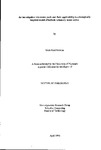An investigation into motor pools and their applicability to a biologically inspired model of ballistic voluntary motor action
| dc.contributor.author | Norman, Mark Paul | |
| dc.contributor.other | School of Engineering, Computing and Mathematics | en_US |
| dc.date.accessioned | 2013-11-04T11:13:30Z | |
| dc.date.available | 2013-11-04T11:13:30Z | |
| dc.date.issued | 1996 | |
| dc.identifier | NOT AVAILABLE | en_US |
| dc.identifier.uri | http://hdl.handle.net/10026.1/2549 | |
| dc.description.abstract |
This study investigates the properties of motor pools in the human motor control system. The simulations carried out as part of this study used two biologically inspired neuronal models to simulate networks with properties similar to those observed in the human motor system (Burke, 1991). The Synchronous neuronal model developed as part of this study explicitly models the input/output spike train and frequency relationship of each neuron. The motor pool simulations were carried out using the INSIGHT TOO simulation software developed as part of this study. INSIGHT TOO is a flexible neural design tool that allows the visual interactive design of network connectivity and has the power of a node specification language similar to that of BASIC that allows multi-layer, multi-model networks to be simulated. The simulations have shown that the motor pools are capable of reproducing commonly observed physiological properties during normal voluntary reaching movements. As a result of these findings a theoretical model of ballistic voluntary motor action was proposed called the Recruitment Model. The Recruitment model utilises the "recruitment" principle known to exist in motor pools and applies this distributed processing methodology to the higher levels of motor action to explain how complex structures similar to the human skeletal system might be controlled. A simple version of the Recruitment Model is simulated showing an animation of a running "stick man". This simulation demonstrates some of the principles necessary to solve problems relating to synergy formation. | en_US |
| dc.language.iso | en | en_US |
| dc.publisher | University of Plymouth | en_US |
| dc.title | An investigation into motor pools and their applicability to a biologically inspired model of ballistic voluntary motor action | en_US |
| dc.type | Thesis | |
| plymouth.version | Full version: final and full version as approved by the examiners at the time of the award of your degree | en_US |
| dc.identifier.doi | http://dx.doi.org/10.24382/3815 | |
| dc.identifier.doi | http://dx.doi.org/10.24382/3815 |
Files in this item
This item appears in the following Collection(s)
-
01 Research Theses Main Collection
Research Theses Main


